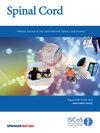Clinical signs and symptoms for degenerative cervical myelopathy: a scoping review of case-control studies to facilitate early diagnosis among healthcare professionals with stakeholder engagement
IF 2.2
4区 医学
Q3 CLINICAL NEUROLOGY
引用次数: 0
Abstract
Scoping Review. Degenerative cervical myelopathy (DCM) is a leading cause of chronic spinal cord dysfunction, with diverse clinical presentations that complicate diagnosis. Therefore, it is important to identify the signs and symptoms of DCM that demonstrate high diagnostic accuracy. This review aims to evaluate the sensitivity and specificity of signs and symptoms in diagnosing DCM. Articles up to June 2024 were retrieved from PubMed, EMBASE, and Cochrane databases using search terms like “degenerative cervical myelopathy”, “cervical spondylotic myelopathy”, “sensitivity”, “specificity”, and related signs and symptoms. Studies were screened based on selection criteria assessing the sensitivity and specificity of signs or symptoms using an appropriate control group. Sixteen studies were included. The most sensitive signs were Tromner sign (93–97%) and hyperreflexia (15–85%). Specific signs included the Babinski sign (93–100%), Tromner sign (79–100%), clonus (96–99%), and inverted supinator sign (78–99%). Neck pain had a sensitivity of 76–94% and specificity of 11–73%. Hand incoordination showed 52% sensitivity and 92% specificity. Altered hand sensation had 76% sensitivity and 90% specificity. Upper extremity weakness had 51–75% sensitivity and 18–95% specificity. Gait imbalance exhibited 56–63% sensitivity and 52–95% specificity. Sensitive signs like the Tromner sign and hyperreflexia are useful for screening, while specific signs such as Babinski, clonus, and the inverted supinator sign aid in confirmation of DCM. Symptoms like neck pain, hand incoordination, and altered hand sensation should heighten suspicion and guide differential diagnosis. Early and accurate diagnosis using these indicators can improve patient outcomes and reduce diagnostic delays.

退行性颈椎病的临床体征和症状:病例对照研究的范围审查,以促进与利益相关者参与的医疗保健专业人员的早期诊断。
研究设计:范围评估。目的:退行性颈脊髓病(DCM)是慢性脊髓功能障碍的主要原因,其临床表现多样,使诊断复杂化。因此,鉴别诊断准确性高的DCM的体征和症状是很重要的。本综述旨在评价诊断DCM的体征和症状的敏感性和特异性。方法:从PubMed、EMBASE和Cochrane数据库中检索截至2024年6月的文章,检索词包括“退行性脊髓型颈椎病”、“脊髓型颈椎病”、“敏感性”、“特异性”和相关体征和症状。根据评估体征或症状的敏感性和特异性的选择标准筛选研究,并使用适当的对照组。结果:纳入16项研究。最敏感的体征为特罗姆纳征(93-97%)和反射性亢进(15-85%)。具体征象包括Babinski征象(93-100%)、Tromner征象(79-100%)、clonus征象(96-99%)和倒旋旋肌征象(78-99%)。颈部疼痛的敏感性为76-94%,特异性为11-73%。手部不协调的敏感性为52%,特异性为92%。手部感觉改变有76%的敏感性和90%的特异性。上肢无力的敏感性为51-75%,特异性为18-95%。步态不平衡敏感性为56-63%,特异性为52-95%。结论:特征性征象如Tromner征象和反射亢进征象有助于筛查,特异性征象如Babinski、clonus、倒旋肌征象有助于确认DCM。颈部疼痛、手部不协调和手部感觉改变等症状应提高怀疑并指导鉴别诊断。利用这些指标进行早期和准确的诊断可以改善患者的预后并减少诊断延误。
本文章由计算机程序翻译,如有差异,请以英文原文为准。
求助全文
约1分钟内获得全文
求助全文
来源期刊

Spinal cord
医学-临床神经学
CiteScore
4.50
自引率
9.10%
发文量
142
审稿时长
2 months
期刊介绍:
Spinal Cord is a specialised, international journal that has been publishing spinal cord related manuscripts since 1963. It appears monthly, online and in print, and accepts contributions on spinal cord anatomy, physiology, management of injury and disease, and the quality of life and life circumstances of people with a spinal cord injury. Spinal Cord is multi-disciplinary and publishes contributions across the entire spectrum of research ranging from basic science to applied clinical research. It focuses on high quality original research, systematic reviews and narrative reviews.
Spinal Cord''s sister journal Spinal Cord Series and Cases: Clinical Management in Spinal Cord Disorders publishes high quality case reports, small case series, pilot and retrospective studies perspectives, Pulse survey articles, Point-couterpoint articles, correspondences and book reviews. It specialises in material that addresses all aspects of life for persons with spinal cord injuries or disorders. For more information, please see the aims and scope of Spinal Cord Series and Cases.
 求助内容:
求助内容: 应助结果提醒方式:
应助结果提醒方式:


